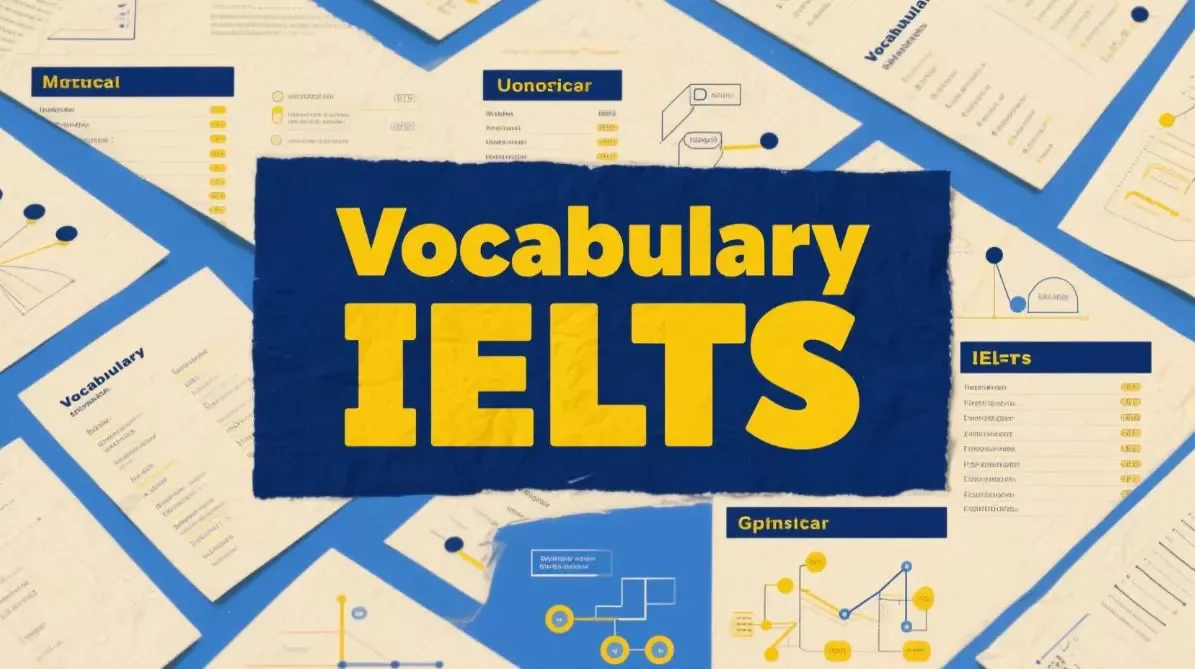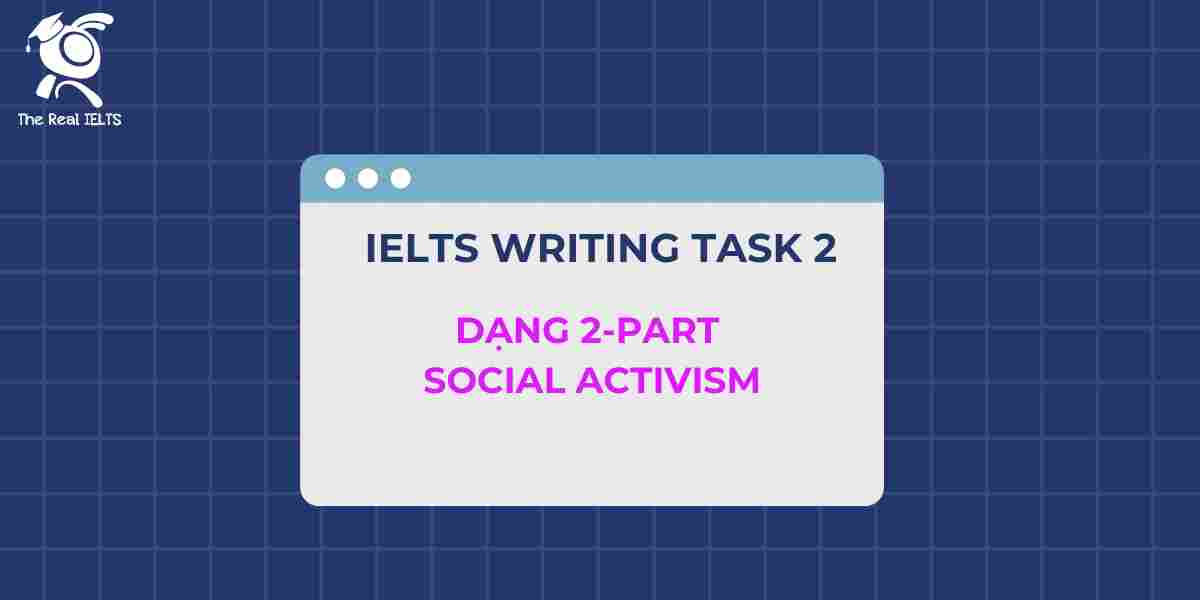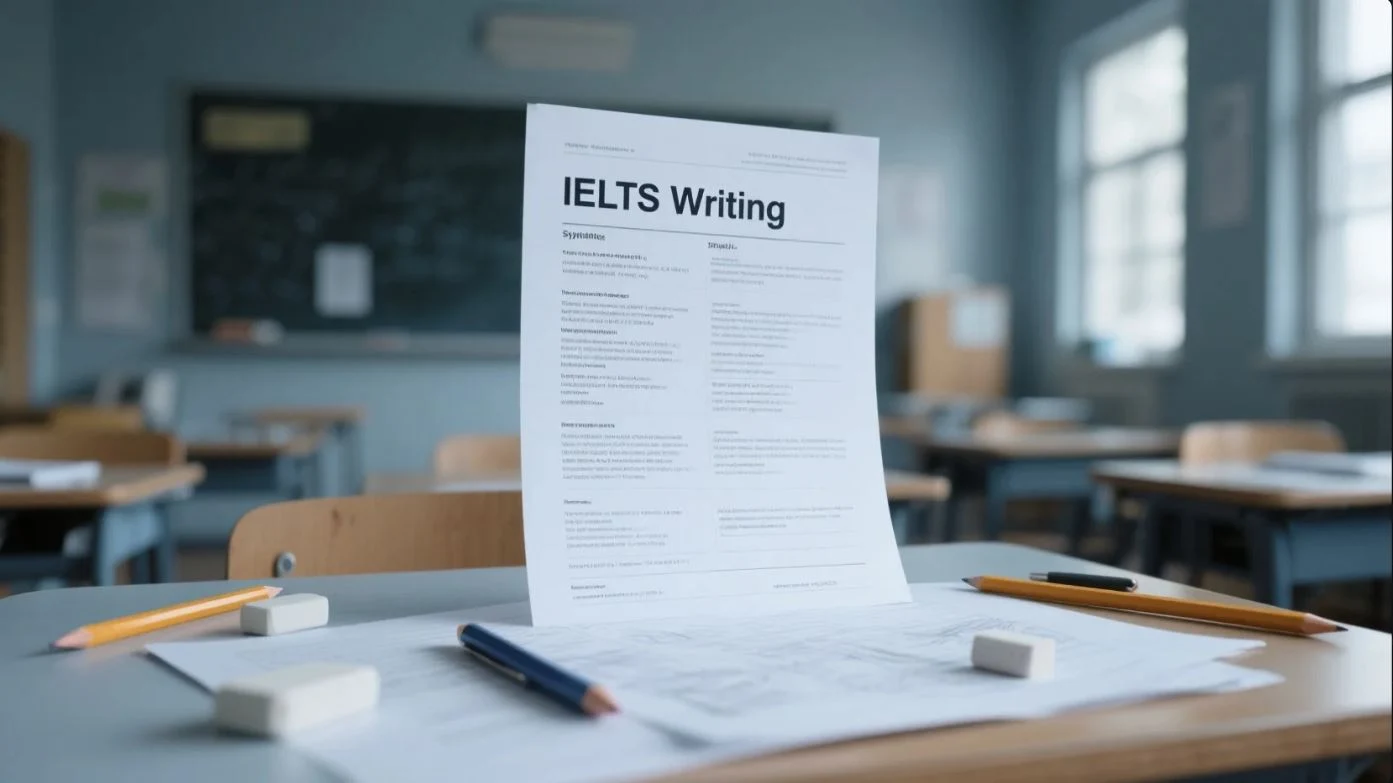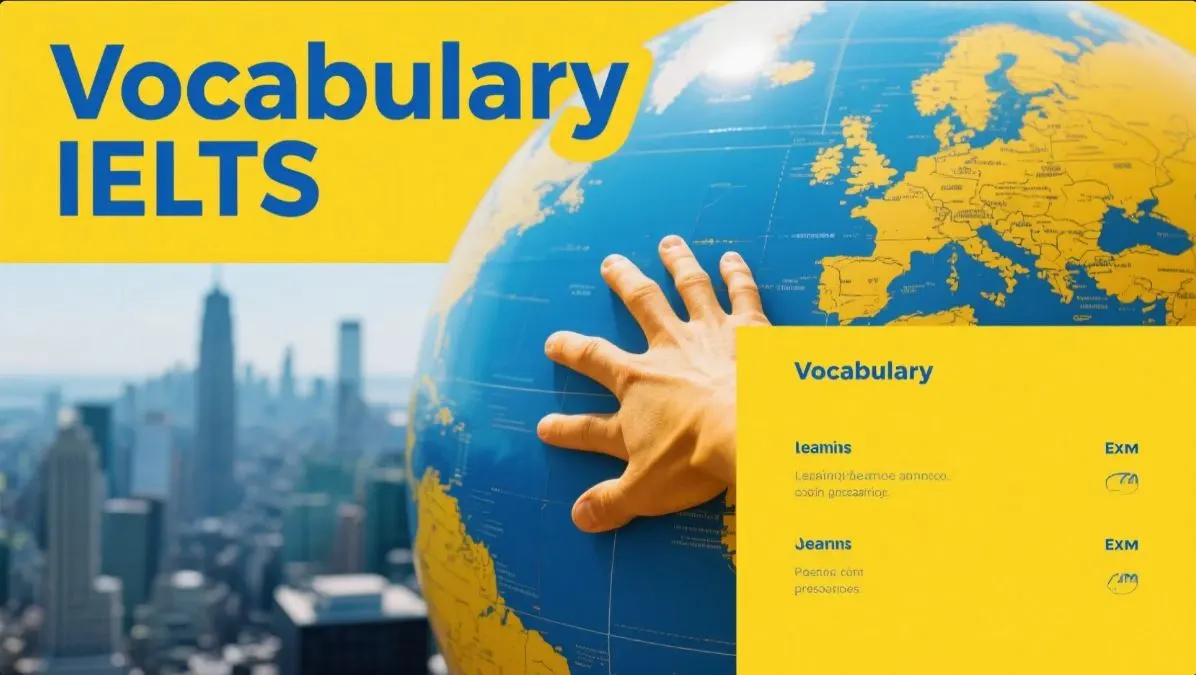Kỹ năng viết là một trong những thách thức lớn nhất đối với thí sinh luyện thi IELTS, đặc biệt ở phần thi IELTS Writing Task 2 Phần 50, nơi yêu cầu tư duy logic và khả năng diễn đạt ý tưởng mạch lạc. Theo thống kê từ Hội đồng Anh, hơn 60% thí sinh gặp khó khăn trong việc xây dựng luận điểm thuyết phục và sử dụng từ vựng học thuật hiệu quả. Hiểu rõ cấu trúc bài thi và chiến lược viết là chìa khóa để đạt điểm cao.
Đọc thêm: IELTS Writing Task 2 Phần 49
Đề 1 IELTS Writing Task 2
Some people believe that governments should invest more in public transportation to reduce traffic congestion and pollution. Others argue that building more roads is a better solution. Discuss both views and give your own opinion.
Bài essay (Band 6.5)
Traffic congestion and pollution are serious issues in many cities. Some people support investing in public transportation, while others think building more roads is more effective. This essay will discuss both views and explain why I believe improving public transport is the better option.
On the one hand, supporters of public transportation argue that it reduces the number of vehicles on the road. Buses and trains can carry many passengers at once, which decreases traffic jams. Moreover, public transport is often powered by electricity or cleaner fuels, so it helps to cut down on emissions. For example, cities like Singapore have efficient subway systems, leading to less air pollution. However, public transport requires high initial costs, and some people find it inconvenient due to fixed schedules.
On the other hand, building more roads is seen as a solution because it provides more space for vehicles. Wider roads or new highways can ease traffic flow, especially in crowded urban areas. For instance, expanding road networks in some cities has reduced travel time. Nevertheless, this approach may encourage more people to drive, leading to even more congestion and pollution in the long term.
In my opinion, investing in public transportation is more sustainable. It not only reduces traffic and pollution but also saves energy. Governments should focus on making public transport affordable and accessible to encourage its use. Building roads may offer short-term relief, but it does not solve the root problems.
In conclusion, while expanding roads can help, improving public transportation is a better long-term solution to tackle congestion(topic) and pollution.
Chấm điểm (4 tiêu chí)
Task Response: 6.5
The essay addresses both views and provides a clear opinion. Arguments are relevant, but the discussion lacks depth, with examples (e.g., Singapore) being brief and not fully developed. The conclusion is clear but repetitive.
Coherence and Cohesion: 6.5
The essay is logically organized with a clear structure. Linking words like “moreover” and “nevertheless” are used appropriately, but transitions between ideas (e.g., from roads to public transport) are sometimes abrupt. Paragraphs are cohesive but could be better connected.
Lexical Resource: 6.5
Vocabulary is appropriate, with some academic phrases like cut down on emissions and sustainable. However, word choice is sometimes repetitive (e.g., “pollution” used multiple times), and there is limited use of higher-level vocabulary.
Grammatical Range and Accuracy: 6.5
The essay uses a mix of simple and complex sentences, such as relative clauses (e.g., “which decreases traffic jams”). There are minor errors (e.g., “tackle congestion(topic)” instead of “congestion”), but they do not impede understanding. More variety in sentence structures could improve the score.
Phân tích từ vựng
- Cut down on emissions
- Nghĩa tiếng Việt: Giảm lượng khí thải.
- Giải thích: Cụm từ này thường dùng trong ngữ cảnh môi trường, chỉ việc giảm thiểu các chất gây ô nhiễm. Trong bài, nó được dùng để nhấn mạnh lợi ích của giao thông công cộng. Thích hợp cho các bài viết về môi trường hoặc giao thông.
- Encourage more people to drive
- Nghĩa tiếng Việt: Khuyến khích nhiều người lái xe.
- Giải thích: Cụm này mang nghĩa thúc đẩy hành vi, thường dùng trong lập luận về tác động của chính sách (e.g., xây đường). Trong bài, nó được dùng để chỉ hệ quả tiêu cực của việc mở rộng đường.
- Sustainable
- Nghĩa tiếng Việt: Bền vững.
- Giải thích: Từ học thuật phổ biến trong các bài viết về môi trường hoặc phát triển dài hạn. Trong bài, nó nhấn mạnh lợi ích lâu dài của giao thông công cộng. Cần chú ý ngữ cảnh để tránh lạm dụng.
- Encourage its use
- Nghĩa tiếng Việt: Khuyến khích sử dụng.
- Giải thích: Cụm này dùng để đề xuất hành động, thường xuất hiện trong phần đưa ý kiến cá nhân. Trong bài, nó được dùng để kêu gọi tăng cường giao thông công cộng.
- Ease traffic flow
- Nghĩa tiếng Việt: Giảm ùn tắc giao thông.
- Giải thích: Cụm từ này mô tả việc cải thiện lưu thông xe cộ, thường dùng trong các bài về giao thông. Trong bài, nó được dùng để mô tả lợi ích của việc xây đường.
Phân tích ngữ pháp
- Relative clauses (e.g., “which decreases traffic jams”)
- Giải thích tiếng Việt: Mệnh đề quan hệ được dùng đúng để bổ sung thông tin (e.g., “which” chỉ lợi ích của giao thông công cộng). Tuy nhiên, bài viết chỉ dùng các mệnh đề đơn giản. Để đạt Band 7, cần thêm mệnh đề quan hệ phức tạp hơn (e.g., “whose”, “whom”).
- Modal verbs (e.g., “should focus on”)
- Giải thích tiếng Việt: Động từ khuyết thiếu được dùng để đưa ra đề xuất, phù hợp với phần ý kiến cá nhân. Trong bài, “should” được dùng đúng, nhưng thiếu sự đa dạng (e.g., “could”, “might”).
- Error: “tackle congestion(topic)”
- Giải thích tiếng Việt: Lỗi này do nhầm lẫn, thêm từ “topic” không cần thiết, làm câu thiếu tự nhiên. Đây là lỗi nhỏ nhưng có thể ảnh hưởng đến ấn tượng tổng thể. Để cải thiện, cần kiểm tra kỹ trước khi nộp bài.
- Simple past tense (e.g., “has reduced travel time”)
- Giải thích tiếng Việt: Thì quá khứ đơn được dùng đúng để mô tả kết quả trong quá khứ. Tuy nhiên, bài viết thiếu các thì phức tạp hơn (e.g., present perfect continuous) để thể hiện sự đa dạng.
Tổng kết & gợi ý cải thiện
Tổng kết: Bài viết đạt Band 6.5 nhờ cấu trúc rõ ràng, từ vựng phù hợp, và lập luận đủ thuyết phục. Tuy nhiên, nó thiếu chiều sâu trong ví dụ, sự đa dạng trong từ vựng/ngữ pháp, và có một số lỗi nhỏ.
Gợi ý cải thiện để đạt Band 7:
- Phát triển ý sâu hơn: Thêm chi tiết cho ví dụ (e.g., giải thích cụ thể cách Singapore giảm ô nhiễm nhờ tàu điện ngầm).
- Đa dạng từ vựng: Thay thế từ lặp lại như “pollution” bằng từ đồng nghĩa (e.g., “air quality issues”).
- Tăng cường ngữ pháp: Sử dụng cấu trúc phức tạp hơn, như câu điều kiện (e.g., “If governments invested more, congestion would decrease”) hoặc mệnh đề quan hệ phức.
- Kiểm tra lỗi: Tránh lỗi nhỏ như “tackle congestion(topic)” bằng cách đọc lại bài.
- Kết nối ý mượt mà hơn: Dùng từ nối phức tạp hơn (e.g., “in contrast to” thay vì “however”) để tăng tính mạch lạc.
Đề 2 IELTS Writing Task 2
Some people believe that governments should spend more money on public transportation to reduce traffic congestion and pollution. Others argue that individuals should take responsibility for reducing their own carbon footprint. Discuss both views and give your own opinion.
Bài essay (Band 6.5)
Traffic congestion and pollution are growing problems in many cities. Some argue that governments should invest more in public transportation to solve these issues, while others believe individuals should take action to reduce their environmental impact. This essay will discuss both perspectives and provide my opinion.
On the one hand, supporters of government investment argue that public transportation is an effective solution to reduce traffic and pollution. By improving buses, trains, and subways, governments can encourage people to use these services instead of private cars. For instance, cities like Singapore have efficient public transport systems, which significantly decrease the number of vehicles on roads. Moreover, cleaner transport options, such as electric buses, can contribute to a reduction in air pollution. Therefore, government funding is seen as a long-term solution to environmental problems.
On the other hand, some believe that individuals should take responsibility for their carbon footprint. People can adopt habits like cycling, walking, or carpooling to reduce their impact on the environment. For example, in many European cities, cycling is popular because it is both eco-friendly and healthy. Additionally, individuals can choose to buy electric cars or limit unnecessary travel. This view emphasizes that personal actions are equally important in addressing environmental challenges.
In my opinion, both approaches are necessary. Governments should prioritize funding for public transport to create sustainable systems, but individuals must also make conscious efforts to reduce their environmental impact. A combination of these efforts will lead to better results.
In conclusion, while government investment in public transportation is crucial, individual responsibility plays a significant role. Both should work together to tackle traffic congestion and pollution effectively.
Chấm điểm (4 tiêu chí)
Task Response: 6.5
The essay addresses both views and provides a clear opinion, meeting the task requirements. However, the arguments lack depth, with examples (e.g., Singapore, European cities) being somewhat general. To reach Band 7, more specific evidence or elaboration is needed.
Coherence and Cohesion: 6.5
The essay is logically organized with clear paragraphing and linking words (e.g., “On the one hand,” “Moreover”). However, transitions between ideas could be smoother, and some sentences feel repetitive. Band 7 requires more varied cohesive devices and seamless flow.
Lexical Resource: 6.5
The vocabulary is appropriate, with some academic phrases (e.g., carbon footprint, long-term solution). However, word choice is occasionally repetitive (e.g., “reduce” used multiple times), and higher-level vocabulary is limited. Band 7 needs more precise and varied word choices.
Grammatical Range and Accuracy: 6.5
The essay uses a range of sentence structures, but minor errors (e.g., article misuse in “contribute to a reduction”) and limited complex sentences prevent a higher score. Band 7 requires more consistent accuracy and varied complex structures.
Phân tích từ vựng
- Carbon footprint
- Nghĩa tiếng Việt: Dấu chân carbon, lượng khí thải carbon do một cá nhân hoặc tổ chức tạo ra.
- Giải thích: Cụm từ học thuật, thường dùng trong các bài viết về môi trường để chỉ tác động của con người lên biến đổi khí hậu. Trong bài, nó được dùng để nhấn mạnh trách nhiệm cá nhân trong việc giảm khí thải.
- Long-term solution
- Nghĩa tiếng Việt: Giải pháp dài hạn.
- Giải thích: Cụm từ này phù hợp với văn học thuật, dùng để chỉ các biện pháp có hiệu quả bền vững. Trong bài, nó ám chỉ lợi ích của đầu tư vào giao thông công cộng.
- Contribute to a reduction
- Nghĩa tiếng Việt: Góp phần giảm thiểu.
- Giải thích: Cụm từ mang tính trang trọng, thường dùng để mô tả tác động tích cực của một hành động. Trong bài, nó được dùng để nói về việc giảm ô nhiễm không khí, nhưng cần chú ý cách dùng đúng cấu trúc (e.g., “a reduction in” thay vì “a reduction of”).
- Equally important
- Nghĩa tiếng Việt: Quan trọng không kém.
- Giải thích: Cụm từ này dùng để so sánh mức độ quan trọng của hai ý tưởng. Trong bài, nó nhấn mạnh rằng hành động cá nhân cũng có giá trị như đầu tư của chính phủ.
- Prioritize funding
- Nghĩa tiếng Việt: Ưu tiên phân bổ ngân sách.
- Giải thích: Cụm từ học thuật, thường dùng khi nói về chính sách công. Trong bài, nó thể hiện quan điểm rằng chính phủ nên tập trung vào giao thông công cộng.
Phân tích ngữ pháp
- Contribute to a reduction
- Giải thích: Trong bài, cụm này đúng nhưng dễ bị nhầm với “contribute to the reduction” (thiếu “in”). Cấu trúc đúng là “contribute to + danh từ” hoặc “contribute to + V-ing”. Lỗi nhỏ về giới từ có thể làm giảm điểm ở Band 7.
- By improving buses, trains, and subways
- Giải thích: Câu này dùng cấu trúc “by + V-ing” để chỉ phương tiện đạt được mục tiêu, đúng ngữ pháp và phù hợp văn học thuật. Tuy nhiên, bài viết thiếu các cấu trúc phức tạp hơn như câu điều kiện hoặc mệnh đề quan hệ, hạn chế điểm ở Band 7.
- Governments should prioritize funding
- Giải thích: Câu này sử dụng động từ khuyết thiếu “should” đúng cách, thể hiện ý kiến cá nhân. Tuy nhiên, bài viết lặp lại cấu trúc “should” nhiều lần, làm giảm sự đa dạng ngữ pháp.
- Cleaner transport options, such as electric buses
- Giải thích: Cụm “such as” được dùng đúng để liệt kê ví dụ. Tuy nhiên, câu này có thể được mở rộng bằng mệnh đề quan hệ (e.g., “which are powered by electricity”) để tăng độ phức tạp, giúp đạt Band 7.
- Individuals can choose to buy
- Giải thích: Cấu trúc “choose to + V” đúng và phù hợp, nhưng bài viết thiếu các cấu trúc nâng cao như câu giả định hoặc bị động, khiến điểm ngữ pháp không vượt quá 6.5.
Tổng kết & gợi ý cải thiện
Tổng kết: Bài viết đạt Band 6.5 nhờ cấu trúc rõ ràng, từ vựng phù hợp, và lập luận cơ bản. Tuy nhiên, nó thiếu sự sâu sắc trong ví dụ, từ vựng đa dạng, và cấu trúc ngữ pháp phức tạp để đạt Band 7. Một số lỗi nhỏ (e.g., bài viết lặp từ “reduce”, thiếu mệnh đề phức) cũng ảnh hưởng đến điểm số.
Gợi ý cải thiện để đạt Band 7:
- Task Response: Thêm ví dụ cụ thể hơn (e.g., số liệu về giảm khí thải ở Singapore) và phân tích sâu hơn về lợi ích hoặc hạn chế của mỗi quan điểm.
- Coherence and Cohesion: Sử dụng các từ nối đa dạng hơn (e.g., “in contrast,” “consequently”) và tránh lặp lại ý.
- Lexical Resource: Thay thế từ lặp như “reduce” bằng từ đồng nghĩa (e.g., “mitigate,” “alleviate”) và dùng collocations học thuật (e.g., “sustainable development”).
- Grammatical Range: Tăng cường câu phức bằng mệnh đề quan hệ, câu điều kiện, hoặc câu bị động. Đảm bảo độ chính xác cao hơn, đặc biệt với giới từ và mạo từ.
Đề 3 IELTS Writing Task 2
Some people believe that governments should invest more in public transportation to reduce traffic congestion and pollution. Others argue that improving road infrastructure for private vehicles is more important. Discuss both views and give your own opinion.
Bài essay (Band 6.5)
Traffic congestion and pollution are growing problems in many cities. Some argue that governments should prioritize public transportation, while others believe improving roads for private vehicles is more essential. This essay will discuss both perspectives and present my opinion.
On the one hand, investing in public transportation can significantly reduce traffic and pollution. Efficient systems like buses and trains can carry many passengers at once, reducing the number of cars on the road. For example, cities like Singapore have reliable public transport, which lowers congestion and encourages people to avoid private vehicles. Moreover, buses and trains produce less pollution per person compared to cars. Therefore, this approach can help create a sustainable environment and improve air quality.
On the other hand, improving road infrastructure for private vehicles has its benefits. Many people rely on cars for convenience, especially in areas with limited public transport. Better roads can enhance traffic flow and reduce travel time. For instance, wider highways or new flyovers can ease congestion in busy cities. However, this solution may not address pollution, as more roads could encourage car usage, leading to higher emissions.
In my opinion, governments should focus on public transportation. It offers a long-term solution to both congestion and pollution, unlike road improvements, which may only provide temporary relief. By investing in affordable and efficient systems, cities can become cleaner and less crowded.
In conclusion, while better roads can improve convenience, public transportation is a more effective way to tackle traffic and pollution. Governments should prioritize it for a sustainable future.
Chấm điểm (4 tiêu chí)
Task Response: 6.5
The essay addresses both views and provides a clear opinion. It includes relevant examples, but the arguments lack depth in places (e.g., the discussion on road improvements is brief). The conclusion aligns with the opinion but could be more impactful.
Coherence and Cohesion: 6.5
The essay is logically organized with clear paragraphs. Linking words like “moreover” and “however” are used, but transitions between ideas (e.g., from road benefits to limitations) could be smoother. Some repetition of ideas reduces cohesion slightly.
Lexical Resource: 6.5
The vocabulary is appropriate, with some academic phrases like significantly reduce and sustainable environment. However, word choice is sometimes repetitive (e.g., “pollution” multiple times), and more variety could enhance the score.
Grammatical Range and Accuracy: 6.5
The essay uses a range of structures, including complex sentences. Errors are minimal but present (e.g., can carry many passengers at once could be more precise). Accuracy is generally good, but minor mistakes prevent a higher score.
Phân tích từ vựng
- Significantly reduce
- Nghĩa tiếng Việt: Giảm đáng kể
- Giải thích: Cụm từ này dùng để nhấn mạnh mức độ tác động lớn, thường xuất hiện trong văn học thuật để chỉ sự thay đổi rõ rệt. Trong bài, nó được dùng để mô tả hiệu quả của giao thông công cộng.
- Ví dụ: “Public transport can significantly reduce traffic congestion.”
- Sustainable environment
- Nghĩa tiếng Việt: Môi trường bền vững
- Giải thích: Cụm từ học thuật, dùng để nói về các giải pháp thân thiện với môi trường, phù hợp với các bài viết về môi trường hoặc phát triển bền vững.
- Ví dụ: “Renewable energy contributes to a sustainable environment.”
- Enhance traffic flow
- Nghĩa tiếng Việt: Cải thiện luồng giao thông
- Giải thích: Cụm từ này mô tả việc cải thiện sự di chuyển của phương tiện, thường dùng trong các bài về giao thông. Nó mang tính trang trọng và phù hợp với IELTS.
- Ví dụ: “New roads can enhance traffic flow in urban areas.”
- Long-term solution
- Nghĩa tiếng Việt: Giải pháp lâu dài
- Giải thích: Dùng để chỉ các biện pháp có hiệu quả bền vững, đối lập với “short-term”. Cụm này phổ biến trong bài Problem-Solution hoặc Discussion.
- Ví dụ: “Education is a long-term solution to poverty.”
- Sustainable future
- Nghĩa tiếng Việt: Tương lai bền vững
- Giải thích: Cụm từ học thuật, thường dùng trong đoạn kết luận để nhấn mạnh tầm quan trọng của các giải pháp lâu dài. Trong bài, nó củng cố ý kiến về giao thông công cộng.
- Ví dụ: “We must act now for a sustainable future.”
Phân tích ngữ pháp
- Can carry many passengers at once
- Giải thích tiếng Việt: Câu này đúng ngữ pháp nhưng thiếu sự tinh tế. Cụm “at once” có thể thay bằng “simultaneously” để trang trọng hơn. Ngoài ra, “many passengers” hơi chung chung, có thể thay bằng “a large number of passengers” để tăng tính học thuật.
- Cách cải thiện: “Can transport a large number of passengers simultaneously.”
- Produce less pollution per person
- Giải thích tiếng Việt: Cấu trúc so sánh “less… than” được dùng đúng, thể hiện sự so sánh giữa giao thông công cộng và xe cá nhân. Tuy nhiên, cụm “per person” cần được dùng cẩn thận để đảm bảo ngữ cảnh rõ ràng. Câu này ổn nhưng có thể thêm từ nối để tăng mạch lạc.
- Ví dụ cải thiện: “Consequently, they produce less pollution per person than cars.”
- Could encourage car usage
- Giải thích tiếng Việt: Modal verb “could” được dùng đúng để diễn tả khả năng, phù hợp với ngữ cảnh lập luận. Tuy nhiên, “car usage” có thể thay bằng “vehicle use” để đa dạng từ vựng. Đây là cấu trúc phổ biến trong IELTS.
- Cách cải thiện: “Could encourage greater vehicle use.”
Tổng kết & gợi ý cải thiện
Tổng kết: Bài essay đạt Band 6.5 nhờ cấu trúc rõ ràng, từ vựng phù hợp, và lập luận cơ bản. Tuy nhiên, nó thiếu sự sâu sắc trong lập luận và đa dạng trong từ vựng/ngữ pháp, khiến điểm bị giới hạn. Một số lỗi nhỏ về ngữ pháp và lặp từ cũng ảnh hưởng đến ấn tượng tổng thể.
Gợi ý cải thiện để đạt Band 7:
- Sâu sắc hơn trong lập luận: Thêm ví dụ cụ thể hoặc giải thích chi tiết hơn (e.g., đề cập đến chi phí của giao thông công cộng so với đường bộ).
- Đa dạng từ vựng: Tránh lặp từ như “pollution” bằng cách dùng từ đồng nghĩa (e.g., “emissions”, “air quality issues”).
- Tăng tính mạch lạc: Sử dụng từ nối phức tạp hơn (e.g., “in contrast” thay cho “however”) và đảm bảo ý trong đoạn liên kết chặt chẽ.
- Ngữ pháp đa dạng: Thêm câu phức với mệnh đề quan hệ hoặc câu điều kiện để tăng độ phong phú.
Đề 4 IELTS Writing Task 2
Some people believe that the best way to reduce crime is to give longer prison sentences. Others, however, think that there are better alternative ways to reduce crime. Discuss both views and give your opinion.
Bài essay (Band 6.5)
Crime is a serious issue in many societies, and people have different opinions about how to tackle it. Some argue that longer prison sentences are the most effective solution, while others believe alternative methods are better. This essay will discuss both perspectives and explain why I support alternative approaches.
On the one hand, supporters of longer prison sentences claim that they deter potential criminals. When people know they could face many years in jail, they may think twice before committing a crime. For example, strict punishments for robbery in some countries have reduced crime rates. Additionally, longer sentences keep dangerous individuals behind bars, protecting society from further harm. However, this approach may not address the root causes of crime, such as poverty or lack of education, and prisons can sometimes make offenders worse.
On the other hand, alternative methods focus on rehabilitation and prevention. Programs like job training or counseling can help offenders change their behavior and reintegrate into society. For instance, community service has been successful in reducing reoffending rates in some places. Moreover, tackling social issues like unemployment can prevent crime before it happens. These methods are often more cost-effective than maintaining prisons and can lead to long-term solutions.
In my opinion, alternative methods are more effective because they address the causes of crime rather than just punishing offenders. While longer sentences may work in some cases, they are not a complete solution. Therefore, governments should invest in prevention and rehabilitation to create a safer society.
In conclusion, although longer prison sentences may deter crime and protect society, alternative methods like rehabilitation and social programs are more effective in reducing crime rates. I believe a combination of both approaches is necessary, but the focus should be on prevention.
Chấm điểm (4 tiêu chí)
Task Response: 6.5
The essay addresses both views and provides a clear opinion, with relevant examples. However, the arguments lack depth, and some ideas (e.g., prisons making offenders worse) are mentioned but not fully developed. To reach Band 7, more detailed explanations and stronger examples are needed.
Coherence and Cohesion: 6.5
The essay is logically organized with clear paragraphs and linking words (e.g., “On the one hand,” “Moreover”). However, transitions between ideas could be smoother, and some sentences feel repetitive. Band 7 requires more varied cohesive devices and seamless flow.
Lexical Resource: 6.5
The vocabulary is appropriate, with some academic phrases (e.g., deter potential criminals, root causes). However, word choice is sometimes repetitive (e.g., “crime” used frequently), and there are no higher-level synonyms or collocations. Band 7 needs more variety and precision.
Grammatical Range and Accuracy: 6.5
The essay uses a mix of simple and complex sentences, with mostly accurate grammar. Errors like “prisons can sometimes make offenders worse” (vague phrasing) and minor article misuse (e.g., “the root causes” instead of “root causes”) prevent a higher score. Band 7 requires more complex structures and fewer minor errors.
Phân tích từ vựng
- Deter potential criminals
- Nghĩa: Ngăn chặn những tội phạm tiềm năng.
- Giải thích: Cụm từ này thường dùng trong ngữ cảnh học thuật để nói về việc giảm hành vi phạm tội thông qua các biện pháp như trừng phạt hoặc giáo dục. Nó mang tính trang trọng và phù hợp với bài viết về an ninh xã hội.
- Behind bars
- Nghĩa: Bị giam giữ, ở trong tù.
- Giải thích: Đây là một cụm từ mang tính hình ảnh, thường dùng để mô tả trạng thái của tội phạm bị cầm tù. Trong bài IELTS, nó giúp tăng tính biểu cảm nhưng cần dùng đúng ngữ cảnh để tránh lạm dụng.
- Root causes
- Nghĩa: Nguyên nhân gốc rễ.
- Giải thích: Cụm từ học thuật này dùng để chỉ các nguyên nhân sâu xa của một vấn đề, như nghèo đói hoặc thiếu giáo dục. Nó phổ biến trong các bài viết về xã hội, nhưng cần giải thích cụ thể để tránh chung chung.
- Tackling social issues
- Nghĩa: Giải quyết các vấn đề xã hội.
- Giải thích: Cụm từ này thường xuất hiện trong các bài viết về chính sách xã hội, thể hiện hành động chủ động đối phó với các vấn đề như thất nghiệp. Nó cần đi kèm ví dụ cụ thể để tăng tính thuyết phục.
- Create a safer society
- Nghĩa: Xây dựng một xã hội an toàn hơn.
- Giải thích: Cụm từ này mang tính tổng quát, thường dùng trong phần kết luận để nhấn mạnh mục tiêu của các biện pháp giảm tội phạm. Tuy nhiên, cần tránh lặp lại quá nhiều cụm tương tự để tăng sự đa dạng.
Phân tích ngữ pháp
- “Prisons can sometimes make offenders worse”
- Giải thích: Câu này sử dụng động từ tình thái “can” để diễn đạt khả năng, nhưng cụm “make offenders worse” hơi mơ hồ và thiếu chi tiết. Để đạt Band 7, cần giải thích rõ tại sao (e.g., “prisons may expose offenders to negative influences”).
- “The root causes”
- Giải thích: Việc dùng mạo từ “the” ở đây không sai nhưng không cần thiết, vì “root causes” là danh từ chung. Người viết Band 6.5 thường gặp lỗi nhỏ về mạo từ, làm giảm độ chính xác. Cần luyện tập dùng mạo từ đúng ngữ cảnh.
- “When people know they could face many years in jail, they may think twice”
- Giải thích: Câu này sử dụng câu điều kiện (if/when + could/may) đúng cách, thể hiện khả năng và kết quả. Đây là một cấu trúc phức tạp phù hợp Band 6.5. Tuy nhiên, để đạt Band 7, cần thêm các cấu trúc phức tạp hơn như câu điều kiện giả định hoặc bị động.
- “Governments should invest in prevention”
- Giải thích: Câu này dùng động từ khuyết thiếu “should” để đưa ra đề xuất, phù hợp với bài nghị luận. Tuy nhiên, cụm “invest in prevention” hơi chung chung. Band 7 yêu cầu cụm từ cụ thể hơn, như “invest in vocational training programs.”
Tổng kết & gợi ý cải thiện
Tổng kết: Bài viết đạt Band 6.5 nhờ cấu trúc rõ ràng, từ vựng phù hợp, và lập luận cơ bản. Tuy nhiên, các ý chưa được phát triển sâu, từ vựng lặp lại, và có một số lỗi ngữ pháp nhỏ. Những hạn chế này ngăn bài viết đạt Band 7.
Gợi ý cải thiện:
- Phát triển ý sâu hơn: Thêm ví dụ cụ thể và giải thích chi tiết, như cách chương trình đào tạo nghề đã giảm tỷ lệ tái phạm ở một quốc gia.
- Đa dạng từ vựng: Sử dụng các từ đồng nghĩa (e.g., thay “crime” bằng “offense” hoặc “delinquency”) và collocations học thuật (e.g., “address underlying factors”).
- Tăng độ phức tạp ngữ pháp: Dùng câu bị động, câu điều kiện giả định, hoặc cấu trúc nhấn mạnh (e.g., “It is rehabilitation that truly reduces crime rates”).
- Cải thiện sự mạch lạc: Sử dụng các từ nối đa dạng hơn (e.g., “In contrast,” “Consequently”) và đảm bảo mỗi đoạn chuyển ý mượt mà.















